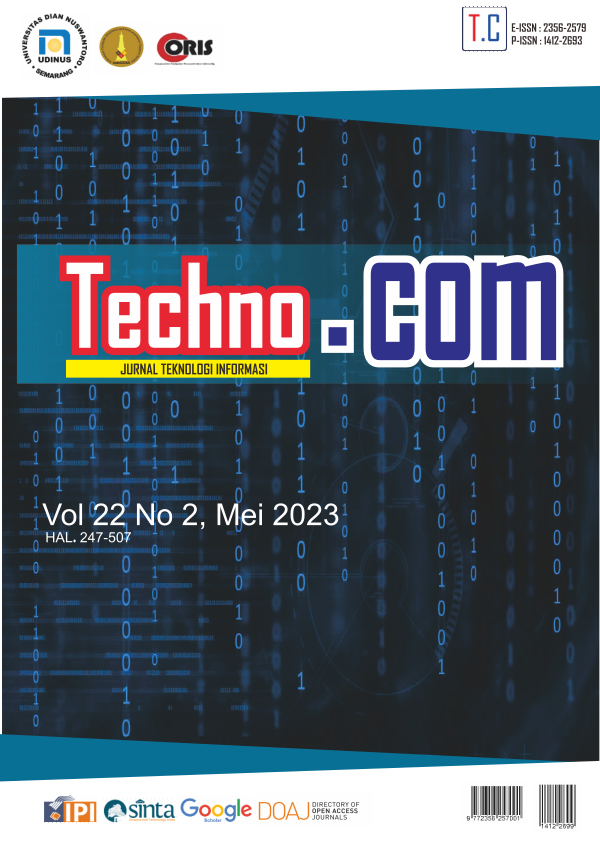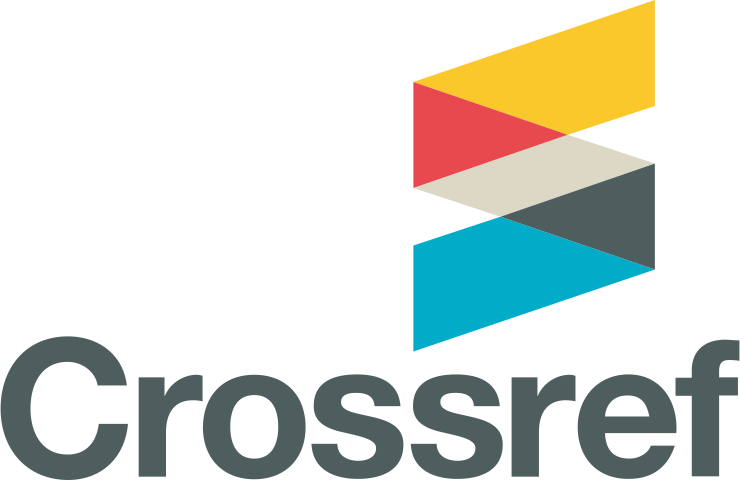Analisis Tingkat Akurasi Variasi Algoritma Min-Max Backpropagation sebagai Pre-Processing Data Time Series
DOI:
https://doi.org/10.33633/tc.v22i2.7995Keywords:
Min-max algorithm, data normalization techniques, time series data, backpropagation algorithmAbstract
Forecasting data does not have to be static, there are also data with high fluctuations with up and down trends. Therefore, data normalization techniques are very important before training and testing data. This paper aims to test eight types of Min-Max backpropagation algorithms with several types of data, namely static data, seational data, monotonically fluctuating data up and down. A backpropagation network architecture with three hidden layers is used to test these data. The test results show that the 6th Min-Max algorithm has a high level of accuracy. Furthermore, the results of the 6th Min-Max modification found that changes in the multiplier variable can reduce the MSE value in the training process to a maximum value of 35.25% and in the testing process to 27.39%. The results of this study can be used as a reference in the future in performing the data nornalization process before the forecasting process is carried out.References
Althelaya, K. A., Mohammed, S. A., & El-Alfy, E. S. M. (2021). Combining deep learning and multiresolution analysis for stock market forecasting. IEEE Access, 9, 13099–13111. https://doi.org/10.1109/ACCESS.2021.3051872
Altrock, P. M., Liu, L. L., & Michor, F. (2015). The mathematics of cancer: Integrating quantitative models. In Nature Reviews Cancer (Vol. 15, Issue 12, pp. 730–745). https://doi.org/10.1038/nrc4029
Amer, M., Daim, T. U., & Jetter, A. (2018). A review of scenario planning. In Technology Roadmapping (pp. 177–232). https://doi.org/10.1142/9789813235342
Ashraf Vaghefi, S., Mousavi, S. J., Abbaspour, K. C., Srinivasan, R., & Yang, H. (2014). Analyses of the impact of climate change on water resources components, drought and wheat yield in semiarid regions: Karkheh River Basin in Iran. Hydrological Processes, 28(4), 2018–2032. https://doi.org/10.1002/hyp.9747
Boillat, S., & Berkes, F. (2013). Perception and interpretation of climate change among quechua farmers of bolivia: Indigenous knowledge as a resource for adaptive capacity. Ecology and Society, 18(4). https://doi.org/10.5751/ES-05894-180421
Buytaert, W., Zulkafli, Z., Grainger, S., Acosta, L., Alemie, T. C., Bastiaensen, J., De Bièvre, B., Bhusal, J., Clark, J., Dewulf, A., Foggin, M., Hannah, D. M., Hergarten, C., Isaeva, A., Karpouzoglou, T., Pandeya, B., Paudel, D., Sharma, K., Steenhuis, T., … Zhumanova, M. (2014). Citizen science in hydrology and water resources: Opportunities for knowledge generation, ecosystem service management, and sustainable development. In Frontiers in Earth Science (Vol. 2). https://doi.org/10.3389/feart.2014.00026
Caroline Kleist. (2015). Time Series Data Mining Methods: A Review. Engineering Applications of Artificial Intelligence, 24(533039), 61.
Chirivella Osma, V., Capilla Romá, J. E., & Pérez Martín, M. A. (2015). Modelling regional impacts of climate change on water resources: the Júcar basin, Spain. Hydrological Sciences Journal, 60(1), 30–49. https://doi.org/10.1080/02626667.2013.866711
Choudhary, A., Pandey, D., & Bhardwaj, S. (2020). Artificial Neural Networks Based Solar Radiation Estimation using Backpropagation Algorithm. International Journal of Renewable Energy Research, 10(4), 1566–1575. https://doi.org/10.20508/ijrer.v10i4.11373.g8041
Cui, X., Guo, X., Wang, Y., Wang, X., Zhu, W., Shi, J., Lin, C., & Gao, X. (2019). Application of remote sensing to water environmental processes under a changing climate. In Journal of Hydrology (Vol. 574, pp. 892–902). https://doi.org/10.1016/j.jhydrol.2019.04.078
Demirel, M. C., Venancio, A., & Kahya, E. (2009). Flow forecast by SWAT model and ANN in Pracana basin, Portugal. Advances in Engineering Software, 40(7), 467–473. https://doi.org/10.1016/j.advengsoft.2008.08.002
Dewi, C., Chen, R. C., Liu, Y. T., & Yu, H. (2021). Various generative adversarial networks model for synthetic prohibitory sign image generation. Applied Sciences (Switzerland), 11(7). https://doi.org/10.3390/app11072913
Dhamma, M., Zarlis, M., & Nababan, E. B. (2017). Multithreading with separate data to improve the performance of Backpropagation method. Journal of Physics: Conference Series, 930(1). https://doi.org/10.1088/1742-6596/930/1/012041
Elgin Christo, V. R., Khanna Nehemiah, H., Minu, B., & Kannan, A. (2019). Correlation-based ensemble feature selection using bioinspired algorithms and classification using backpropagation neural network. Computational and Mathematical Methods in Medicine, 2019. https://doi.org/10.1155/2019/7398307
Estrela, T., Perez-Martin, M. a, & Vargas, E. (2012). Impacts of climate change on water resources in Spain. Hydrological Sciences Journal-Journal Des Sciences Hydrologiques, 57(6), 1154–1167.
Fu, T. C. (2011). A review on time series data mining. In Engineering Applications of Artificial Intelligence (Vol. 24, Issue 1, pp. 164–181). https://doi.org/10.1016/j.engappai.2010.09.007
Gowda, C. C., & Mayya, S. G. (2014). Comparison of Back Propagation Neural Network and Genetic Algorithm Neural Network for Stream Flow Prediction. Journal of Computational Environmental Sciences, 2014, 1–6. https://doi.org/10.1155/2014/290127
Guan, C., & Yang, Y. (2020). Research of extraction behavior of heavy metal Cd in tea based on backpropagation neural network. Food Science and Nutrition, 8(2), 1067–1074. https://doi.org/10.1002/fsn3.1392
Madhiarasan, M., & Deepa, S. N. (2016). A novel criterion to select hidden neuron numbers in improved back propagation networks for wind speed forecasting. Applied Intelligence, 44(4), 878–893. https://doi.org/10.1007/s10489-015-0737-z
Nourbakhsh, H., Emam-Djomeh, Z., Omid, M., Mirsaeedghazi, H., & Moini, S. (2014). Prediction of red plum juice permeate flux during membrane processing with ANN optimized using RSM. Computers and Electronics in Agriculture, 102, 1–9. https://doi.org/10.1016/j.compag.2013.12.017
Premalatha, N., & Valan Arasu, A. (2016). Prediction of solar radiation for solar systems by using ANN models with different back propagation algorithms. Journal of Applied Research and Technology, 14(3), 206–214. https://doi.org/10.1016/j.jart.2016.05.001
Qiu, J., Jammalamadaka, S. R., & Ning, N. (2020). Multivariate time series analysis from a Bayesian machine learning perspective. Annals of Mathematics and Artificial Intelligence, 88(10), 1061–1082. https://doi.org/10.1007/s10472-020-09710-6
Rohman, E. M. S., & Rachmad, A. (2016). Predicting Medicine-Stocks by Using Multilayer Perceptron Backpropagation. Journal Article IJSEA, 5(3), 188–191.
Setti, S., & Wanto, A. (2019). Analysis of Backpropagation Algorithm in Predicting the Most Number of Internet Users in the World. Jurnal Online Informatika, 3(2), 110. https://doi.org/10.15575/join.v3i2.205
Sharma, B., & K. Venugopalan, P. (2014). Comparison of Neural Network Training Functions for Hematoma Classification in Brain CT Images. IOSR Journal of Computer Engineering, 16(1), 31–35. https://doi.org/10.9790/0661-16123135
Syaharuddin, Fatmawati, & Suprajitno, H. (2022). Investigations on Impact of Feature Normalization Techniques for Prediction of HydroClimatology Data Using Neural Network Backpropagation with Three Layer Hidden. International Journal of Sustainable Development and Planning, 17(7), 2069–2074. https://doi.org/https://doi.org/10.18280/ijsdp.170707
Syaharuddin, Pramita, D., Nusantara, T., Subanji, & Negara, H. R. P. (2020). Analysis of accuracy parameters of ANN backpropagation algorithm through training and testing of hydro-climatology data based on GUI MATLAB. IOP Conference Series: Earth and Environmental Science, 413(1). https://doi.org/10.1088/1755-1315/413/1/012008
Yang, Z., Liu, S., Li, Z., Jiang, Z., & Dong, C. (2021). Application of machine learning techniques in operating parameters prediction of Stirling cryocooler. Cryogenics, 113. https://doi.org/10.1016/j.cryogenics.2020.103213
Downloads
Published
Issue
Section
License
License Terms
All articles published in Techno.COM Journal are licensed under the Creative Commons Attribution-NonCommercial 4.0 International (CC BY-NC 4.0). This means:
1. Attribution
Readers and users are free to:
-
Share – Copy and redistribute the material in any medium or format.
-
Adapt – Remix, transform, and build upon the material.
As long as proper credit is given to the original work by citing the author(s) and the journal.
2. Non-Commercial Use
-
The material cannot be used for commercial purposes.
-
Commercial use includes selling the content, using it in commercial advertising, or integrating it into products/services for profit.
3. Rights of Authors
-
Authors retain copyright and grant Techno.COM Journal the right to publish the article.
-
Authors can distribute their work (e.g., in institutional repositories or personal websites) with proper acknowledgment of the journal.
4. No Additional Restrictions
-
The journal cannot apply legal terms or technological measures that restrict others from using the material in ways allowed by the license.
5. Disclaimer
-
The journal is not responsible for how the published content is used by third parties.
-
The opinions expressed in the articles are solely those of the authors.
For more details, visit the Creative Commons License Page:
? https://creativecommons.org/licenses/by-nc/4.0/
















